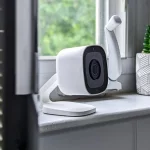Your Guide to Installing Window Locks
It’s hard to rest easy when one’s home isn’t perfectly secure, especially with all the break-ins happening everywhere. So, how do you ensure that your windows are burglar-proof, and which type of lock best fits it?
Many people face another dilemma, which is whether or not they have to replace their classical casement windows with newer uPVC ones.
This article answers all your questions and explains in full detail how to select and install the right locks.
Types of Window Locks
The material, size, and type of your window dictate the type of lock you can install. You also need to specify the degree of protection your home requires. The crime stats in some neighbourhoods truly necessitate installing the best lock you can get.
Here are the main categories you can choose from.
Lever, Folding, and Sash Window Locks
All these locks employ a simple mechanism to keep the window panes tightly closed. They seem to be invincible, but they wouldn’t take two minutes in a professional burglar’s wicked hands.
If you need a higher level of protection, you can install a chain lock, or better yet, a keyed lock.
UPVC Window Locks
Modern residences often come with a different type of window. Unplasticised polyvinyl chloride is commercially known as uPVC. Its recent popularity is bolstered by its durability and energy efficiency. It doesn’t need much maintenance, and that’s another one of its many charms.
A great feature of uPVC windows is that they’re lockable. More often than not, their locks are barrel-and-key types, which makes them pretty secure.
Keyed Locks
You can close a window by moving a lever. This is sufficient to keep a child from harm's way, but it’s not enough to deter a cat burglar.
A keyed lock is much better at securing the window than a simple latch, wedge, or sash lock. You can mount keyed locks on almost any type of window, whether it’s single-hung, double-hung, or sliding.
Smart Locks
These brainy locks are becoming all the rage nowadays. For starters, they don’t need a key, which is a huge plus for the forgetful types who keep misplacing their keys.
Besides being a great time saver, a smart lock is also quite practical. You can check the locks’ status on your phone, and, if necessary, you can lock it remotely.
Sliding and Casement Window Locks
Windows that open outward, or sliding ones, can be a bit challenging, but there are clever ways to install lockable catches on them. Naturally, the locks are modified to permit free movement of the window panes, while securing them in place, if needed.
Window Pin Locks or Chain Locks
This is often a bit harder to overcome than a simple lever or sash lock. Using these locks, you can leave a window ajar for a dash of fresh air.
Common Problems with Window Locks
It’s hard to imagine that a simple mechanism like a window lock could be problematic. Yet, lock jamming incidents happen all the time. It’s advantageous to anticipate these common issues and know how to deal with them.
Frozen, Jammed, or Rusted Lock
A lock filled with debris or rust wouldn't engage easily, or at all. You can clean up the area around the lock, and, if possible, use a blower to clean up the enclosed parts. Having done that, add a drop of lubricant to the moving parts to resuscitate your lock.
A rusty lock needs special treatment. You’d have to remove the rust using home remedies or an industrial rust remover. If it’s too invasive, or the lock is too stubborn, then it should be replaced.
Lost Keys
An interesting 2020 study showed that Brits misplace around 7.9 billion items every year. Keys are second on the list, right after glasses.
The wise thing to do then is to keep a copy of the keys somewhere safe, and known, to all the household. Alternatively, you can install a smart lock.
Broken Key Inside the Lock
That’s seriously unfortunate, as it’s a double damage of both the lock and key. You can use thin pliers to pry the broken part of the key, and if you have a spare key, then all is well.
If not, then a locksmith’s visit will clear that up. Window security locks should be fully functional at all times.
Loose Lock or Key That Doesn’t Always Work
Flimsy screws that barely hold the lock in place are a real menace. The lock is there, but it’s not performing its job.
Fortunately, this is easy to fix, as you only need to tighten the screws in place. In extreme cases, the lock would be old and worn out, so replacing it is unavoidable.
Occasionally, a key doesn’t enter snugly into the keyhole and wiggles around as you insert it. This is a rare event. But, if it happens, the whole lock and key system needs to be replaced.
Misaligned Latches
Two reasons cause misalignment: a glitch in installation and ageing. A few millimetres here and there would resist proper lock engagement, but you can realign the parts to regain proper functionality.
A weatherbeaten lock, or window system, would stubbornly refuse to work in unison. In this case, a locksmith would have to assess the situation and propose a suitable course of action.
How to Install a Window Lock
If you have a deft hand with tools, then installing a window lock should be a breeze. Just choose the right lock for your window type and material, and the rest is easy.
Gather Your Tools
Here are some of the tools and materials you’ll need:
- New lock and key kit;
- Two screwdrivers of suitable sizes and types (preferably the ones with a magnetic tip);
- Measuring tape;
- Ruler;
- Pencil/marker;
Remove the Old Lock
If you’re replacing an old lock, use the screwdriver to remove the screws, and pry the lock carefully out of the window.
The place where the existing lock was mounted is often filled with dust and debris, so try to clean that up before proceeding to the next step.
Prepare the Window
The lock should fit right into the position reserved for the old one, but that’s not always the case. If that happens, consider yourself lucky. If not, there’s some more prep work to be done.
Use the measuring tape to mark the points where the new lock should be mounted, and drill the holes as needed.
Install the New Lock
Place the lock in its marked position, but wait a bit before screwing it in place. It’s best to check the alignment of the lock with the window frame. This little step can save you tons of troubleshooting later on.
Make Sure It’s Working Correctly
Installing window locks with keys is a straightforward process. It’s not immune to misalignment though, so no need to panic if it doesn’t work perfectly from the get-go.
Alignment is often the issue if the lock doesn’t engage. Even a few millimetres can hinder proper locking and unlocking. Unscrew the lock, realign it, and then secure it in place.
Some locks need a bit of lubricating to work properly, but be careful with the juice. A tiny bit of grease goes a long way.
Not all locks are purely mechanical, some come with fancy electronics. So, if you install a smart lock, you need to check all the functions as outlined in its installation manual.
When to Call a Locksmith
Window lock emergencies are often caused by a locked window that wouldn’t open, or one with a faulty mechanism that can’t engage no matter what.
In some cases, you can sort out the problem by fastening the lock in place, or by greasing it. Realigning the window panes is a bit technical, but you can manage it.
A lost or broken key is a more advanced situation that requires a specialist’s magic touch.
Consider hiring an emergency locksmith in the following situations:
- You’re not too fond of handiwork;
- It’s a red tape requirement to get the approval of an insurance company;
- The key broke inside the lock;
- The smart lock manufacturer insists that a company representative install the lock;
- You need to know that your house is safe and secure.
Conclusion About Installing Window Locks
At this point, you should be well-versed in choosing a suitable lock for your window. You can install it, and you’re more than ready to do basic troubleshooting.
Remember, a secure home is a happy home. Enjoy the peace of mind that comes with knowing that you did everything you could to protect your family.
More to Read:
Previous Posts:




